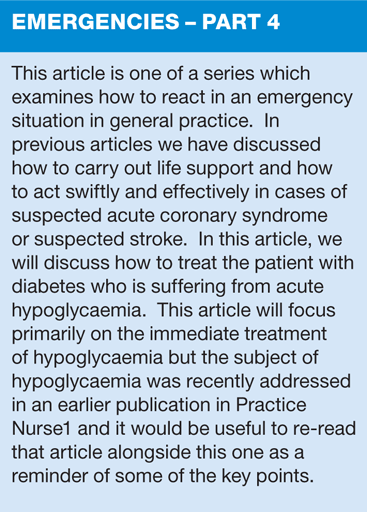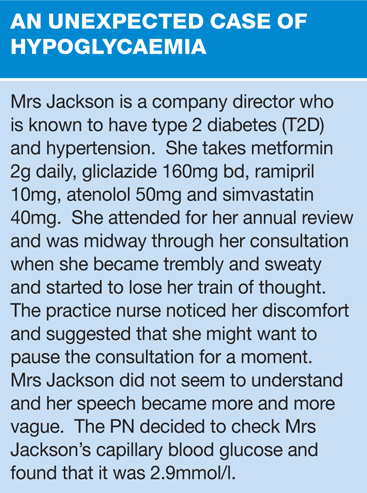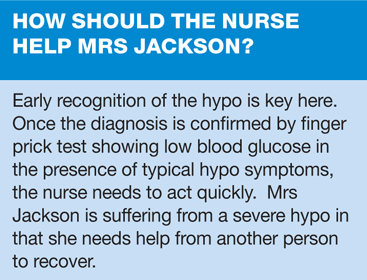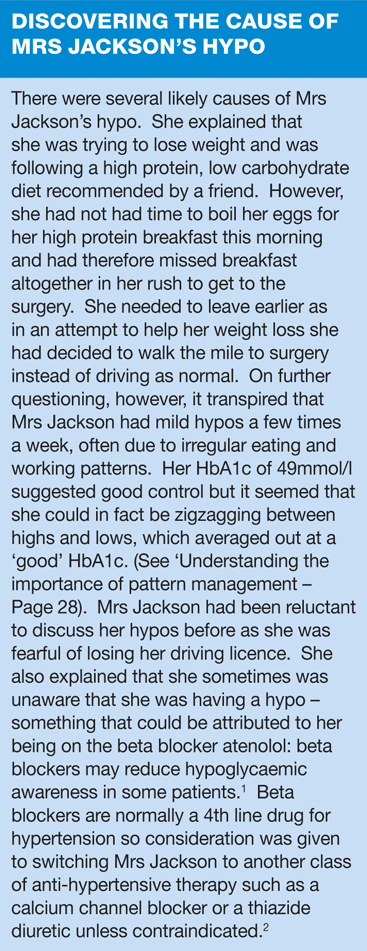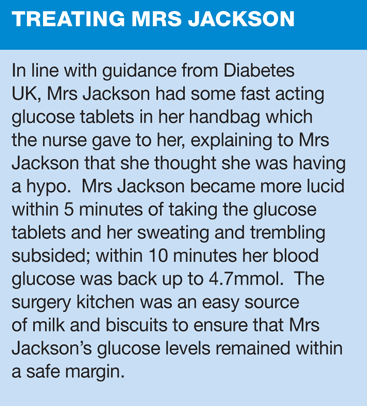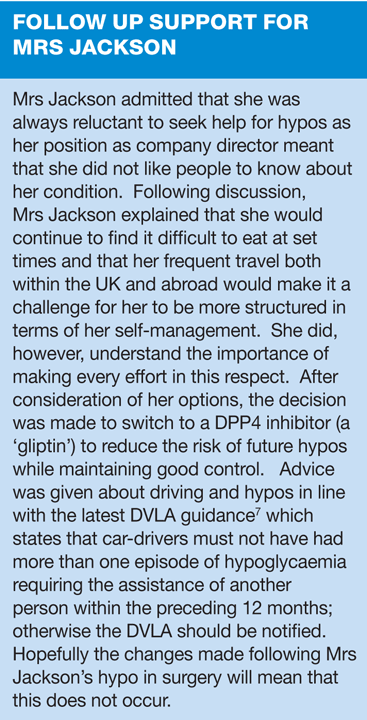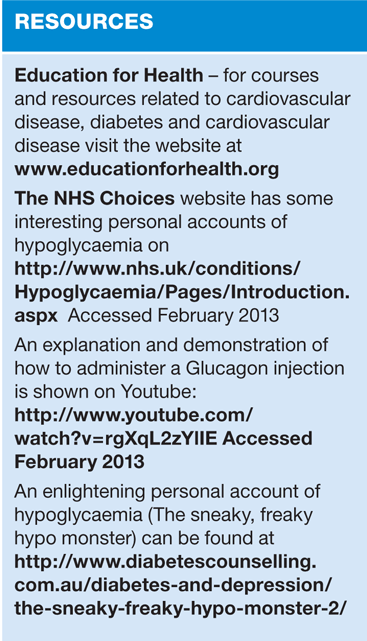Dealing with emergencies in general practice: The patient with hypoglycaemia
Beverley Bostock-Cox
Beverley Bostock-Cox
RGN, BSc, MSc
Nurse Practitioner, Sky Blue Medical Group, Coventry, Clinical Lead, Education for
Health, Warwick
As in other emergency situations in general practice, the practice nurse's response to a patient presenting with symptoms of hypoglycaemia needs to be prompt. If not treated quickly, blood glucose levels can continue to drop leading to loss of consciousness, fitting or death
DEFINITION, SIGNS AND SYMPTOMS
The word hypoglycaemia literally means low sugar in the blood and is defined when the blood glucose level drops below 3.5-4mmol/l. Many, but not all, people with diabetes will experience symptoms before blood levels drop this low and these may be symptoms which they have recognised from previous episodes. They might include shaking, sweating, palpitations or feeling 'vague' or especially hungry. If people who are known to have diabetes begin to suffer from these symptoms, they should be aware of the importance of immediately letting someone else know how they are feeling so they have some help if required; they should then measure their capillary blood glucose as soon as possible and immediate action should be taken to avoid worsening hypoglycaemia. Severe hypoglycaemia, defined as an episode which requires the help of another person to recover, can be life-threatening so early action will be required.
CAUSES
Drugs used to treat diabetes by lowering blood glucose levels, in particular sulfonylureas and insulin, are commonly implicated in episodes of hypoglycaemia. However, other causes may include forgetting to take or mistiming taking their diabetes medication or forgetting to eat at the appropriate time. Excessive amounts of exercise especially if these are unusual for that individual may also cause hypoglycaemia.
ACTION
Swift action will be required as soon as hypoglycaemia is recognised as a cause of symptoms. This will mean ensuring that the patient has access to some form of glucose as soon as possible in an easily absorbable form. Diabetes UK3 and the TREND report4 both suggest a fast acting carbohydrate followed by a slower acting carbohydrate if required, in other words if it is not a normal meal time for that individual.
Fast acting carbohydrates include:
- A small can of non-diet fizzy drink.
- A small carton of smooth orange juice.
- Five or six dextrose tablets.
- Four large jelly babies.
- Seven large jelly beans.
- Two tubes of glucose gel (GlucoGel, previously known as Hypostop)
This should be repeated in 5-10 minutes if the blood glucose levels have not risen to over 4mmol/l.
Slower acting carbohydrates include:
- A small sandwich
- A bowl of cereal
- Milk and biscuits
- A banana
If the patient is losing or has lost consciousness and cannot consume any food, an injection of glucagon can be given by the health care professional in attendance to raise blood glucose levels swiftly and ensure the patient regains consciousness. Once the patient has recovered enough to be able to eat, oral carbohydrates should then be given as described above. Glucagon is licensed to use in people on insulin who have suffered a severe hypoglycaemic event and is given at a dose of 0.5 mg for children under the age of 12, or 1mg for age 12 and over.5 The drug can be given best intramuscularly or by deep subcutaneous injection. In severe cases, intravenous glucose may be administered by the emergency services.
EDUCATION AND SUPPORT
After a hypoglycaemic attack, especially if it is a severe episode requiring help from another person, a general review should be undertaken to try to identify the underlying reason and address it. The patient may need to swap to newer therapies which have less risk of hypoglycaemia. They may also need education and support about lifestyle interventions which may reduce the risk of further episodes such as eating regularly and understanding how exercise, stress and illness can affect glycaemic control. Patients should be reminded that getting help from another person may be necessary so people around her should be aware of her diabetes and what to do in the event of a hypo. A recent survey by Diabetes UK showed that many people keep their diabetes secret.6
CONCLUSION
In summary, then, people with diabetes are at risk of suffering from hypoglycaemia. This risk increases with more erratic lifestyles and where drugs are used which are known to increase the risk of hypoglycaemia, such as insulin, sulfonylureas and meglitinides. Patients and clinicians should be aware of the signs and symptoms of hypoglycaemia and should know how to treat it quickly and effectively to avoid more serious consequences. Holistic management of hypoglycaemia should include lifestyle and pharmacological interventions aimed at avoiding future episodes.
REFERENCES
1. Lowth M. Hypoglycaemia: Prevention and Management Practice Nurse 23 November 2012;42(18):12-16
2. NICE (2011) Hypertension: clinical guideline 127. Available at http://publications.nice.org.uk/hypertension-cg127 Accessed February 2013
3. Diabetes UK (2012) Hypoglycaemia. Available at http://www.diabetes.org.uk/Guide-to-diabetes/Complications/Hypoglycaemia/ Accessed February 2013
4. TREND Recognition, treatment and prevention of hypoglycaemia in the community report (2011) Available at http://trend-uk.org/Trend_report_to_print.pdf Accessed February 2013
5. Electronic Medicines Compendium (2013) Glucagon injection. Available at http://www.medicines.org.uk/EMC/medicine/4258/SPC/GlucaGen+Hypokit+1+mg/ Accessed February 2013
6. Diabetes UK (2011) One million risk health by keeping diabetes secret. Available at http://www.diabetes.org.uk/About_us/News_Landing_Page/One-million-risk-health-by-keeping-diabetes-secret/ Accessed February 2013
7. DVLA (2011) Diabetes Mellitus. Available at http://www.dft.gov.uk/dvla/medical/aag/chapterview/Diabetes%20mellitus.aspx Accessed February 2013
Related articles
View all Articles
